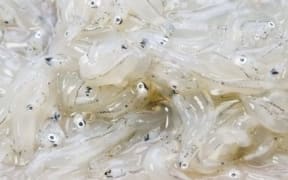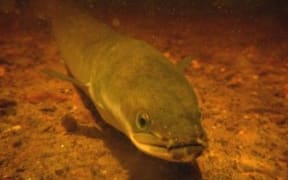Not everyone's celebrating the start of the whitebait season this weekend, with growing anger among some Māori over what they say is the commercialisation of the delicacy.

Whitebait Photo: 123rf
The season begins on 15 August, except on the West Coast, where it starts on 1 September.
Tāngata whenua say they have grave concerns about the long-term drop in whitebait numbers due to dairy intensification, erosion and over-fishing.
Willy Wetere is from the Maniaroa Marae at Awakino Heads in Waikato.
He said as tāngata whenua, his biggest concern about whitebaiting on the Awakino River was the commercialisation of the fishery. He said last season fishers reported healthy catches.
"People are allowed to sell their catch from the Awakino, which encourages overfishing in my opinion," Mr Wetere said. "And if you look at any other species in New Zealand, this is the only one you can sell that has no quota management or monitoring on it. To me that's just madness."
Mr Wetere would like to see more research done into whitebait stocks and better management put in place around its fishing.
He said the rules were inconsistent and the financial reward for selling whitebait was too attractive for conservationists to get much of a look in.
"If I went down and caught a snapper and sold that down the butcher's I'd be in a lot of trouble, right? I don't see that they (whitebaiters) do anything different.
"I bought some at $130 a kilo once, that's a very attractive offer to bring to people."
Commercial whitebaiting "a reality"
Greg White is spokesperson for Ngāti Tama, whose rohe borders the Mōkau River in Taranaki.
He said commercial whitebaiting was a reality whether regulators liked it or not, and he had heard of whitebait stands changing hands for close to $20,000.
"Whitebaiters are an oddball type of person. They go up there and sit there for hours and I know that they enjoy it, but they also enjoy selling it, and the commercial return determines the value of the jetty that they have."
Mr White wanted to see better management of the whitebait stands on the Mokau River.
"You drive up Mōkau River and it's just cluttered with whitebait stands, so I guess we'd like to see that managed a little better.
"It just seems to be open slather. If you're lucky enough to be first in best dressed, and got yourself a licence or permit to build a stand, you're going to be better off then everybody else."
Cassandra Crowley is the general manager of Te Korowai o Ngāruahine Trust in South Taranaki.
She said there were several issues affecting whitebait numbers.
"I think in Taranaki you have to look at the level of sediment flow that we have off our hillsides, the impact of pastoral usage, high intensity dairying and the activities that are going on offshore.
"All of that together creates a very difficult environment and stressed environment for fish to live in, and to thrive and survive in."
Ms Crowley said she hoped overfishing was now an historic problem and said that fishers could help preserve whitebait by being aware of the environment and abiding by the rules.
Department of Conservation senior ranger Callum Lilley said it certainly seemed that over time whitebait catches in Taranaki had declined, although some years were good in the north and poor in the south, and vice versa.
Big fish tales
"Historically there are stories of people fertilising their lemon trees with whitebait and using them for stock food, so ... it sounds like there were huge numbers. There are stories about it being difficult to lift your net out of the water."
Mr Lilley doubted whitebait numbers would ever return to those levels, but said there were steps being put in place to aid the fishery's recovery.
He hoped fishers would moderate their take, but admitted there was no catch limit.
"There isn't a limit, but you need to follow [http://www.doc.govt.nz/parks-and-recreation/things-to-do/fishing/whitebaiting/whitebait-regulations-all-nz-except-west-coast/
certain rules]. There's rules about fishing gear and not modifying stream beds and things like that, but there's no set limit, a daily limit or anything like that."
Mr Lilley said regional authorities were responsible for regulations about the placement of whitebait stands.
The Waikato Regional Council administers whitebait stands on the Mōkau and Awakino Rivers. The stands are a permitted activity.
They must be solely for the purpose of whitebaiting, be no closer than 20 metres from an existing stand and have an area of no more than 4 metres.
For most of Aotearoa the whitebait season opens on Saturday and runs until November 30, but on the West Coast of the South Island it opens on September 1 and runs until November 14.



